|
Books by
Jeffery Robenalt
|
|
|
At
the conclusion of the French and Indian War in 1763, the victorious
English forced the French to cede the Louisiana Territory to Spain.
In an era before the invention of rails or other efficient land
transport, Spain now controlled the Mississippi River and the port
of New Orleans, the only outlet to the sea for the center of the
North American continent. However, Spain suffered from the same
weakness that plagued France in its attempts to control the vast
territory straddling the Mississippi River; a critical lack of Spanish
subjects willing to settle on and actually take physical possession
of the land.
Since the ethnic homogeneity of New Spain had already been shattered
when many French citizens were incorporated during the takeover
of Louisiana, Don Francisco Bouligny, a Spanish officer commanding
in Missouri, proposed that Louisiana be populated by providing land
grants to American settlers. Of course, the Americans would have
to comply with Spanish law by converting to Catholicism and swearing
allegiance to the King of Spain. Bouligny’s plan proved to be successful
under the leadership of empresarios such as George Morgan,
who established the settlement of New Madrid on the west bank of
the Mississippi across from the mouth of the Ohio River. However,
the experiment with pluralism and free immigration came to an end
in 1803, when the United States purchased the Louisiana Territory
from France who had recently reacquired it.
At the stroke of Napoleon’s pen, Spanish Texas shared a border with
a virtual horde of land-hungry Americans who had long ago developed
a taste for territorial expansion. With a sense of “manifest destiny”
that foretold of a country which would one day span the entire continent
from ocean to ocean, it is little wonder that New Spain was soon
gripped by an attitude approaching a phobia toward all Anglo-Americans
and their attempts to settle in Spanish Texas. It is against this
background that the filibusters (Spanish for pirate or freebooter)
cut a brief, but bloody, swath across the old Southwest.
|
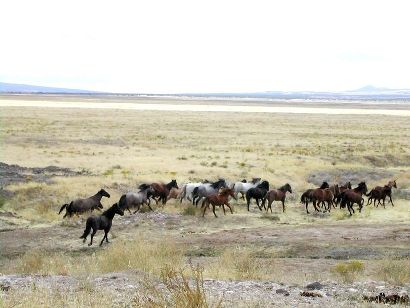 |
Wild Mustangs
by Jaime Jackson
Wikimedia Commons |
|
The
first of the American filibusters, Philip
Nolan, was not a filibuster in the truest sense of the word.
Nolan,
an educated man who immigrated to America from Ireland, was involved
in the business of capturing wild horses in Texas
and selling them in New Orleans. In 1797, Nolan
signed a contract with the French governor of Louisiana, Baron de
Carondelet, to sell the mustangs to a Louisiana regiment. Carondelet
knew Nolan
was conducting illegal roundup operations in Texas, but he was not
always on the best of terms with his Spanish counterpart, Texas
Governor Manuel Munoz. Nolan
also came to a financial agreement with Governor Munoz to ignore
his illegal activities, and the American’s mustanging operations
continued unabated for the next few years.
In October of 1800, Nolan
again reentered Texas with twenty men
and a few slaves, but by this time a new governor, Juan Bautista
de Elguezabal, had been appointed. Governor Elguezabal issued an
order that all Americans exhibiting the least suspicious conduct
should be arrested. This order definitely pertained to Philip
Nolan, who the governor learned had been meeting in secret with
General James Wilkinson, the commander of the American Army in the
west, to discuss the separation of Texas
from New Spain. Orders were issued to all Spanish patrols to permanently
silence Nolan
if he returned to Texas.
|
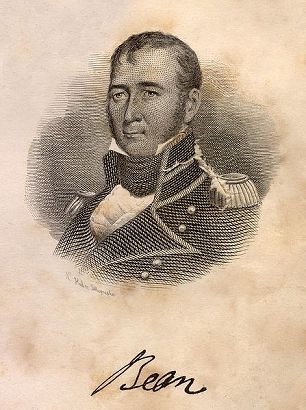 |
Peter Ellis
Bean
Wikipedia |
|
Within a few
days, a company of Spanish cavalry under the command of Lieutenant
Musquiz tracked Nolan
down at a camp on the Brazos River where the mustanger had assembled
nearly three hundred wild horses. The Spanish surrounded the camp
by night and attacked at sunrise. During a brief, but vicious fight
Philip Nolan
was killed and Peter
Ellis Bean took command. Heavily outnumbered and nearly
out of ammunition, Bean soon surrendered. Lieutenant Musquiz marched
the survivors into Mexico, noting in his journal that he had granted
Nolan’s
slaves permission to bury their master “after causing his ears to
be cut off in order to send them to the Governor.”
The King of Spain eventually decreed that every fifth prisoner should
be hanged as a pirate and the rest sentenced to ten years at hard
labor. By then all but nine of the filibusters had died in prison,
so the survivors were blindfolded and made to throw dice. Ephraim
Blackburn, who threw the lowest number, was duly hanged. The fate
of the other prisoners except for Peter
Ellis Bean has been lost and long-forgotten over time, but Bean,
a true survivor, was later made a colonel in the Mexican army, married
a rich widow, and died of old age in a warm and comfortable bed.
After
the United States’ purchase of Louisiana, the border between Louisiana
and Texas immediately came into question.
Although the generally accepted border was the Sabine River,
Spanish authorities insisted their territory extended to the Arroyo
Hondo some fifty miles further to the east, while the United States
claimed a line that lay much further to the west. Minor clashes
between American and Spanish troops over the border continued until
1806, when General Wilkinson met with Spanish General
Simon Herrera and reached a compromise, agreeing to create a
neutral zone from the Arroyo Hondo to the Sabine.
|
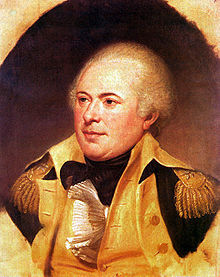 |
General
James Wilkinson
Wikipedia |
Neutral Ground
Agreement
Wikipedia |
|
According to
the agreement, neither country would try to take control of the
neutral ground between the rivers or patrol it with their troops.
The so-called Neutral Ground Agreement brought a halt to
the frequent skirmishing along the border, but it had the unfortunate
consequence of creating a haven for outlaws, murderers, and smugglers
from both countries. Eventually, Spain agreed to permit a unit of
the United States Army under the command of Lieutenant Augustus
Magee to enter the Neutral Ground and clean out the nest of outlaws.
Soon after returning to New Orleans and resigning his commission
in the army, Augustus Magee met Bernardo Gutierrez de
Lara, a former follower of Mexican revolutionary leader and
priest, Father
Miguel Hidalgo y Costilla. Before he was captured and executed
by the Spanish, Father
Hidalgo sent Gutierrez to New Orleans to gather support for
the revolution. Gutierrez and Magee were destined to continue the
filibuster movement by assembling a group of volunteers made up
of Anglo-Americans, Tejanos, Indians, former slaves, and adventurers
of all manner and reputation. In 1812, the pair proceeded to march
their diverse little army into Spanish Texas, where they easily
occupied Nacogdoches
and declared the Republic of the North to be independent of Spain.
Gutierrez and Magee next marched to the presidio of La Bahia near
the settlement of Goliad,
where they were attacked by a force under the command of Spanish
Governor Manuel Salcedo. Magee was killed during the fighting. Undeterred,
the filibusters, now under the command of first Samuel Kemper
and then Henry Perry, advanced on San Antonio and again met
the Spanish forces under Governor Salcedo at the Battle of Salado
in February 1813. The filibusters routed the Spanish and occupied
the old mission town.
With the occupation of San
Antonio, the filibusters controlled the three most important
settlements in Spanish Texas. Unfortunately, the Anglo filibusters
were in favor of establishing a republican form of government, and
the Tejano filibusters wanted a government based on the Spanish
model. Many Anglos gave up in frustration and returned to the United
States when the two sides could not come to an agreement.
In August 1813, as the argument over the form of government continued
to rage, a large force of Spanish soldiers under the command of
General Joaquin de Arredondo advanced on San
Antonio. The disorganized filibusters met Arredondo’s forces
fifteen miles south of town on the banks of the Medina River
in what was to become the bloodiest battle in Texas history. Refusing
to allow the filibusters to surrender, the Spanish killed most of
them and proceeded to execute the residents of San Antonio de Bexar
who had conducted business with the usurpers. Although the Republic
of the North was crushed, a few of the men who accompanied Gutierrez
and Magee would live to one day see their dreams of a free Texas
come to pass.
|
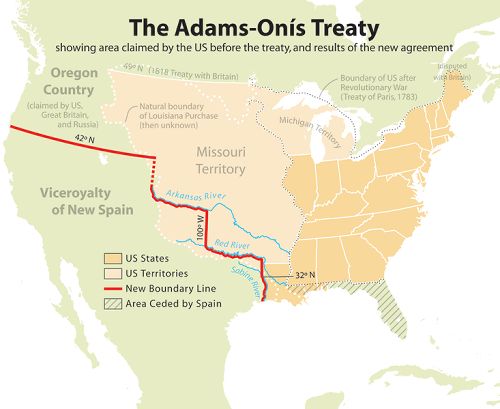 |
Adams-Onis Treaty
Map
Wikimedia
Commons |
The official
border between the United States and Spanish Texas was finally settled
in 1819, when Secretary of State and future president, John Quincy
Adams negotiated the Adams-Onis
Treaty with Spanish diplomat Luis de Onis. Unfortunately,
this diplomatic effort did not prevent Dr. James Long from
leading the last filibuster into Texas.
In June 1819, Dr. Long, with the help of the citizens of Natchez,
Mississippi, organized and equipped an expedition “to invade Texas
and establish a Republic.” The good doctor had gained his reputation
fighting at New Orleans alongside his friend and mentor Andrew Jackson.
He also married the niece of General James Wilkinson. Taking his young
wife Jane and his infant child, Dr. Long marched for Texas
with only eighty men. However, by the time he crossed the Sabine River
the force had grown to nearly three hundred, including the former
Mexican revolutionary, Bernardo Gutierrez de Lara.
After easily capturing Nacogdoches,
which the Spanish left nearly undefended, a convention was convened
and Texas was declared a free and independent
republic with Dr. Long as its Chief of State. The new President immediately
began selling Texas land on generous
terms and sent men to establish outposts on the Trinity and Brazos
Rivers. |
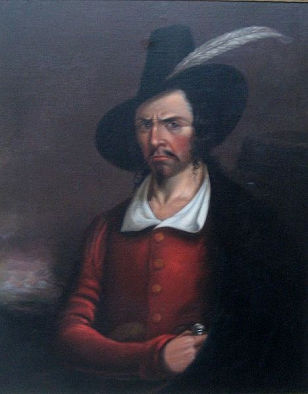 |
Once this was
accomplished, Dr. Long set out for Galveston Island, seeking the assistance
of Jean Lafitte. Although
the famed pirate, who was the true power in the region, greeted Dr.
Long and his delegation cordially, wishing them every success in their
endeavors, he wisely refused to become involved in the filibuster.
In fact, he stated no group of Mexican revolutionists and American
adventurers could hope to gain control of Texas
without the assistance of a well-disciplined fighting force, something
which Long surely did not possess.
On his return to Nacogdoches,
Dr. Long found the settlement nearly deserted. In his absence, his
forces had been soundly defeated by the Spanish who killed his brother
and captured most of his settlers. The survivors including his wife
and child fled to Louisiana. With no choice, Long crossed back over
the Sabine into the safety of the United States and rejoined his family.
However, even though his efforts had been met with one setback after
another, Long remained convinced that Texas
was there for the taking, and he returned to New Orleans with thoughts
of organizing a new expedition.
In spite of his earlier failure, Dr Long had no trouble finding supporters
for his latest scheme, and again accompanied by his wife and now two
small children, he set out for Texas.
This time he led an expedition that traveled by sea, making landfall
at a place known as Point Bolivar. Long ordered his men to build a
small fort on the site and, leaving his wife and children behind,
marched his army inland to La Bahia. La Bahia, as Nacogdoches
had previously, easily fell into the hands of the American invaders,
but a strong force of Spanish royalists soon surrounded Long’s ragtag
troops and forced them to surrender.
After his capture, Dr. Long was sent to Mexico City where he was later
shot by a prison guard during an alleged escape attempt. Jane Long
went back to Mississippi when she learned of her husband’s death,
but later returned to Texas and eventually
settled in Richmond. She operated a successful hotel and a plantation,
and became one of the most prominent pioneer women in Texas.
Today Jane Long is known as the “Mother of Texas.”
Though the filibusters were unsuccessful in gaining independence for
Texas, their efforts were not entirely in vain. Reports of their activities
in newspapers and periodicals all across the country brought the vast
land of Texas to the forefront of American
thought and encouraged countless settlers to pull up stakes and journey
to the new land of promise. This quiet flood tide of American settlement
served more to loosen Spanish, and later Mexican, control of Texas
than any of the filibuster expeditions, and led to the era of the
Texas Empresarios.
© Jeffery
Robenalt, September
1, 2011 Column
More "A Glimpse of Texas Past"
About Jeffery Robenalt |
|
|
